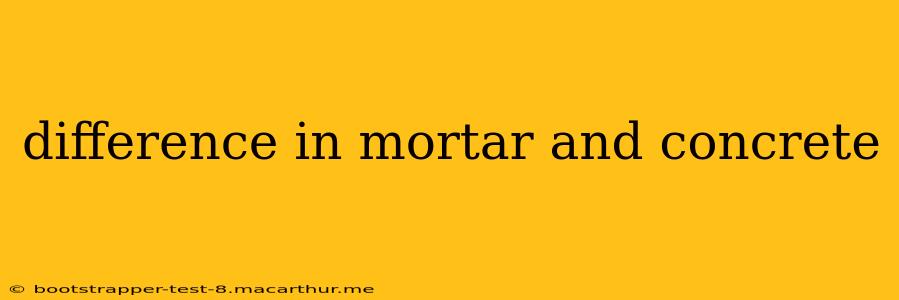Mortar and concrete are both construction materials made from a mixture of cement, aggregates, and water. However, their composition and applications differ significantly. Understanding these differences is crucial for any construction project, whether you're a seasoned professional or a DIY enthusiast. This guide will delve into the key distinctions, helping you choose the right material for your needs.
What is Mortar?
Mortar is a binding agent primarily used to bond or join masonry units like bricks, blocks, and stones. It's a mixture of cement (or lime), fine aggregate (typically sand), and water. The key characteristic of mortar is its workability—it needs to be easily spread and molded to fill gaps and create a strong bond. It's not designed to bear significant structural loads on its own.
Key Properties of Mortar:
- Lower compressive strength: Compared to concrete, mortar has significantly lower compressive strength.
- High workability: It's designed for easy application and molding.
- Fine aggregate: Uses fine sand as its primary aggregate.
- Primarily used for bonding: Its main function is to bind masonry units together, not to support structural weight.
What is Concrete?
Concrete is a composite material made from cement, coarse aggregate (like gravel or crushed stone), fine aggregate (sand), and water. Unlike mortar, concrete is designed to bear significant structural loads. It's used to create foundations, slabs, walls, and other structural elements. Its strength and durability are key features.
Key Properties of Concrete:
- High compressive strength: Concrete possesses significantly higher compressive strength than mortar.
- Lower workability: It's less workable than mortar and requires specialized equipment for mixing and placing.
- Coarse aggregate: Includes larger aggregates like gravel or crushed stone, providing increased strength and stability.
- Primarily used for structural elements: It forms the structural framework of buildings and other structures.
What are the Main Differences Between Mortar and Concrete?
The table below summarizes the key differences:
| Feature | Mortar | Concrete |
|---|---|---|
| Primary Use | Bonding masonry units | Structural applications |
| Compressive Strength | Low | High |
| Aggregate | Fine (sand) | Fine (sand) and Coarse (gravel/stone) |
| Workability | High | Lower |
| Structural Load Bearing | Minimal | High |
What Type of Aggregate is Used in Mortar and Concrete?
Mortar typically uses fine aggregate, primarily sand, to achieve the desired workability. The sand particles fill the gaps between the masonry units, ensuring a strong bond. Concrete, on the other hand, utilizes both fine and coarse aggregates. The coarse aggregate, like gravel or crushed stone, significantly increases the concrete's compressive strength and durability. The mix ratio of fine and coarse aggregate will vary depending on the specific application and desired properties.
Is Mortar Stronger Than Concrete?
No, concrete is significantly stronger than mortar. Concrete's higher compressive strength comes from the inclusion of coarse aggregate and a different mix ratio. Mortar is not designed to support heavy loads; its strength is sufficient for binding masonry units.
Can Mortar Be Used for Structural Purposes?
Mortar is not suitable for structural applications. It lacks the compressive strength to bear significant loads and would fail under stress. Its role is purely to bind masonry units together, creating a strong and stable wall or structure. Using mortar for structural purposes is unsafe and violates building codes.
By understanding these crucial differences, you can make informed decisions about which material is best suited for your specific project, ensuring the safety and durability of your construction work.
